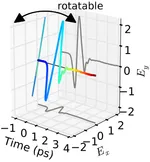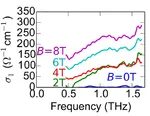Ultrafast & Terahertz Photonics: Publications
Filter by PI:
Filter by topic:
Terahertz spectroscopy of anisotropic materials using beams with rotatable polarization
C. D. W. Mosley, M. Failla, D. Prabhakaran and J. Lloyd-Hughes
Scientific Reports 7:12337 (Sept 2017) [ pdf ][ ref ]
We introduce a polarization-resolved terahertz time-domain spectrometer with a broadband (0.3-2.5THz), rotatable THz polarization state, and which exhibits minimal change in the electric field amplitude and polarization state upon rotation. This was achieved by rotating an interdigitated photoconductive emitter, and by detecting the orthogonal components of the generated THz pulse via electro-optic sampling. The high precision (<0.1°) and accuracy (<1.0°) of this approach is beneficial for the study of anisotropic materials without rotating the sample, which can be impractical, for instance for samples held in a cryostat. The versatility of this method was demonstrated by studying the anisotropic THz optical properties of uniaxial and biaxial oxide crystals. For uniaxial ZnO and LaAlO3, which have minimal THz absorption across the measurement bandwidth, the orientations of the eigenmodes of propagation were conveniently identified as the orientation angles that produced a transmitted THz pulse with zero ellipticity, and the birefringence was quantified. In CuO, a multiferroic with improper ferroelectricity, the anisotropic THz absorption created by an electromagnon was investigated, mapping its selection rule precisely. For this biaxial crystal, which has phonon and electromagnon absorption, the polarization eigenvectors exhibited chromatic dispersion, as a result of the monoclinic crystal structure and the frequency-dependent complex refractive index.
introduce a polarization-resolved terahertz time-domain spectrometer with a broadband (0.3-2.5THz), rotatable THz polarization state, and which exhibits minimal change in the electric field amplitude and polarization state upon rotation. This was achieved by rotating an interdigitated photoconductive emitter, and by detecting the orthogonal components of the generated THz pulse via electro-optic sampling. The high precision (<0.1°) and accuracy (<1.0°) of this approach is beneficial for the study of anisotropic materials without rotating the sample, which can be impractical, for instance for samples held in a cryostat. The versatility of this method was demonstrated by studying the anisotropic THz optical properties of uniaxial and biaxial oxide crystals. For uniaxial ZnO and LaAlO3, which have minimal THz absorption across the measurement bandwidth, the orientations of the eigenmodes of propagation were conveniently identified as the orientation angles that produced a transmitted THz pulse with zero ellipticity, and the birefringence was quantified. In CuO, a multiferroic with improper ferroelectricity, the anisotropic THz absorption created by an electromagnon was investigated, mapping its selection rule precisely. For this biaxial crystal, which has phonon and electromagnon absorption, the polarization eigenvectors exhibited chromatic dispersion, as a result of the monoclinic crystal structure and the frequency-dependent complex refractive index.
Colossal terahertz magnetoresistance at room temperature in epitaxial La0.7Sr0.3MnO3 nanocomposites and single-phase thin films
J. Lloyd-Hughes, C. D. W. Mosley, S. P. P. Jones, M. R. Lees, A. Chen, Q. X. Jia, E. M. Choi and J. L. MacManus-Driscoll
Nano Lett. 17:2506 (Mar 2017) [ pdf ][ ref ]
We show that colossal magnetoresistance persists up to THz frequencies, in manganite nanocomposites and thin films. At the metal-insulator transition the THz conductivity of the nanocolumn film was dramatically enhanced by the application of a magnetic field, creating a non-Drude conductivity that increased with frequency. Surprisingly, the observed colossal THz magnetoresistance is large for ac motion on nanometre length scales, even when the dc magnetoresistance on macroscopic length scales is negligible.
show that colossal magnetoresistance persists up to THz frequencies, in manganite nanocomposites and thin films. At the metal-insulator transition the THz conductivity of the nanocolumn film was dramatically enhanced by the application of a magnetic field, creating a non-Drude conductivity that increased with frequency. Surprisingly, the observed colossal THz magnetoresistance is large for ac motion on nanometre length scales, even when the dc magnetoresistance on macroscopic length scales is negligible.
